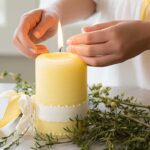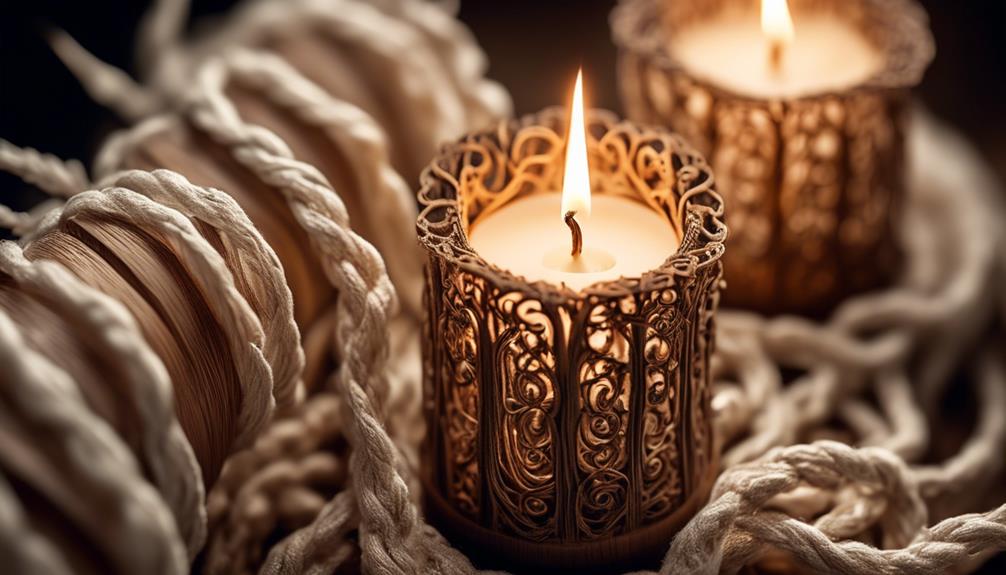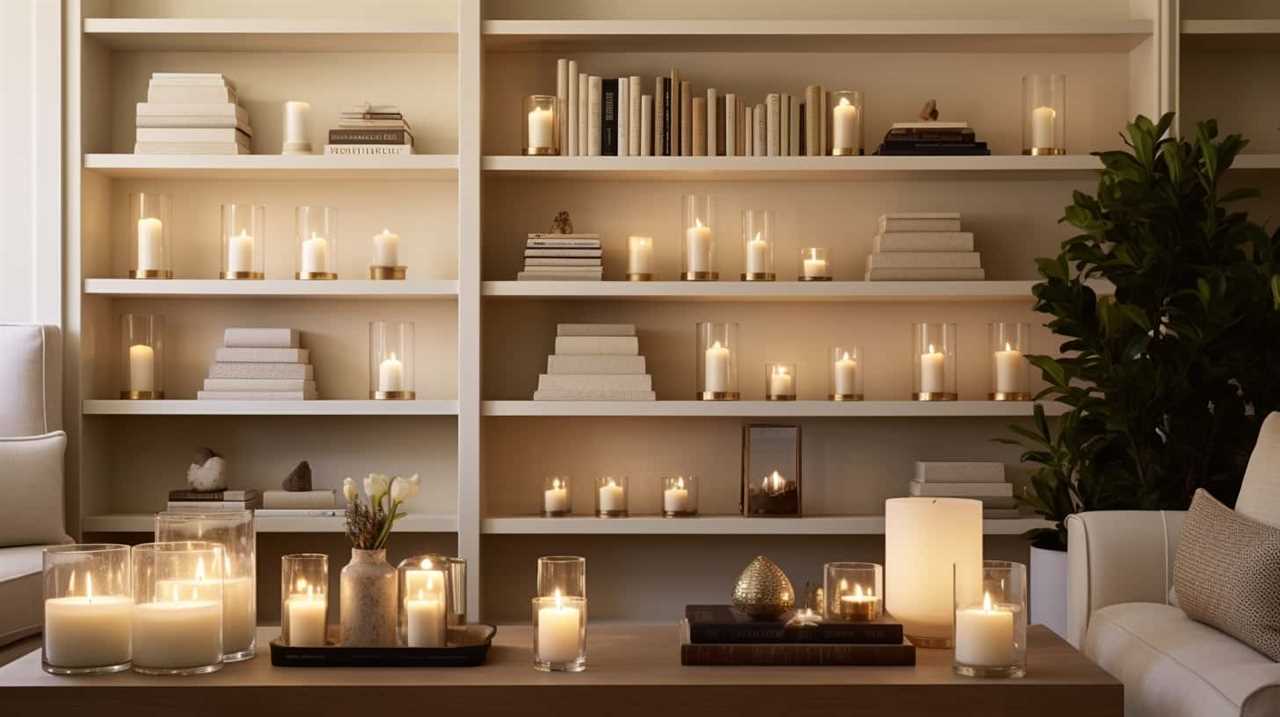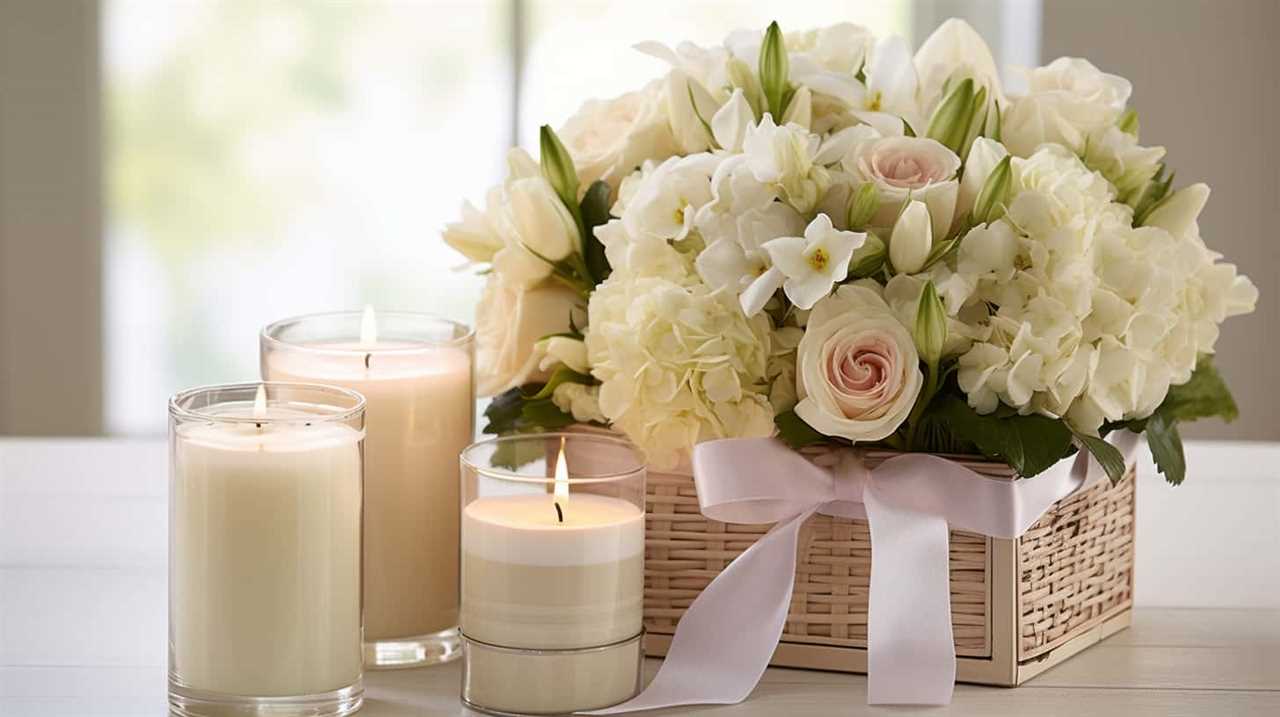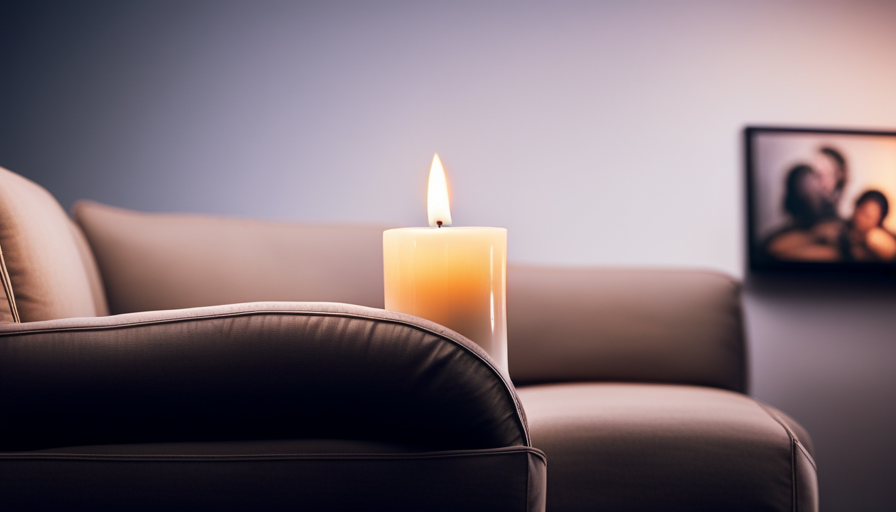Have you ever wondered why the scent of your candle doesn’t spread throughout the room magically? Let’s take a closer look at this puzzling phenomenon and find a solution.
In this guide, we will explore the possible reasons behind the lack of scent in your candle. From the quality of the wax to the selection and maintenance of the wick, we will uncover the secrets to achieving a delightful aroma.
We will also discuss the importance of candle size, burn time, scent concentration, and quality. Additionally, we will touch on the significance of candle placement, airflow, and even the storage and shelf life of candles.
Lastly, we will address any external factors that may be affecting your ability to fully experience the intended scent. Get ready to enhance your candle experience and enjoy the soothing ambiance it brings.
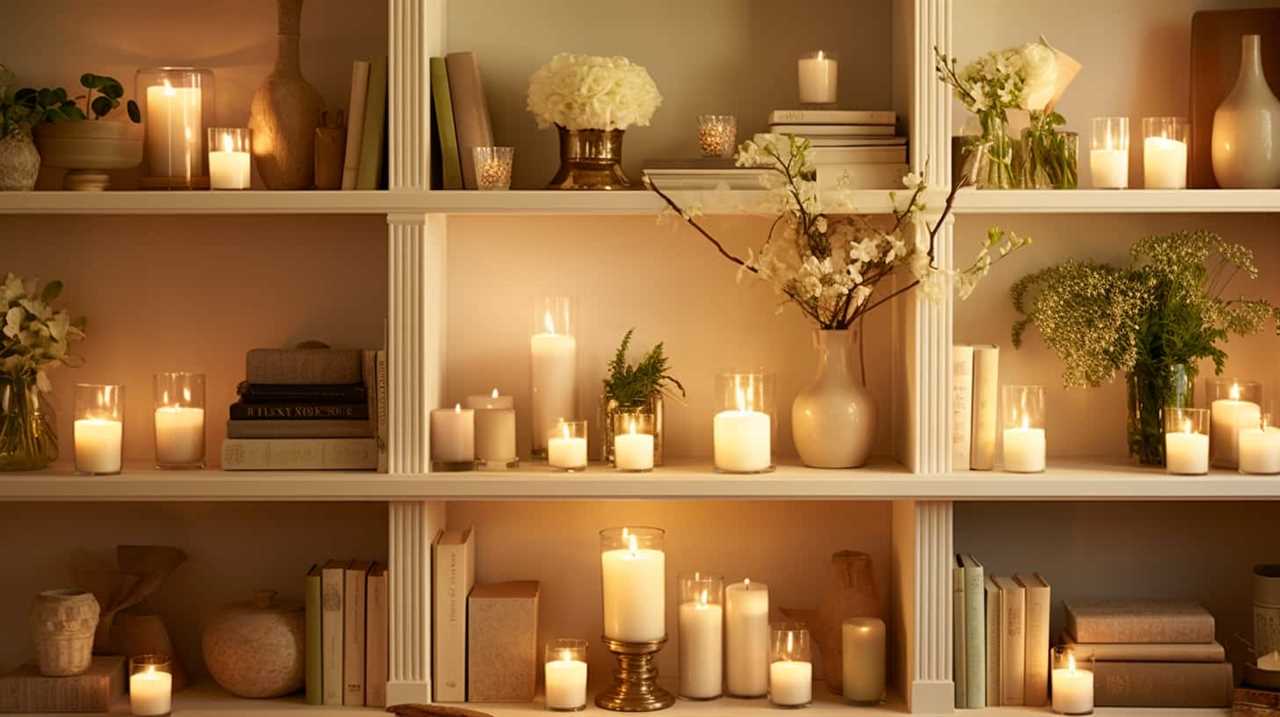
Key Takeaways
- Candle size and burn time are important factors that affect the scent throw of a candle.
- Scent concentration and quality play a crucial role in ensuring an enjoyable candle experience.
- Proper candle placement and airflow are essential for maximizing scent distribution.
- The storage conditions and shelf life of candles can impact their fragrance and quality.
Quality of the Candle Wax
When choosing a scented candle, we often overlook the importance of the quality of the candle wax.
The candle fragrance and scent longevity largely depend on the type of wax used. High-quality candle wax, such as soy or beeswax, is known for its ability to hold and release fragrances effectively, ensuring a long-lasting and pleasant scent experience. These waxes have a lower melting point, which allows the fragrance oils to blend seamlessly and evenly throughout the candle.
As a result, the scent is dispersed consistently, providing a more robust and lasting aroma.
On the other hand, lower-quality waxes, like paraffin, may not hold and distribute the fragrance as effectively, leading to a weaker scent and shorter scent longevity.
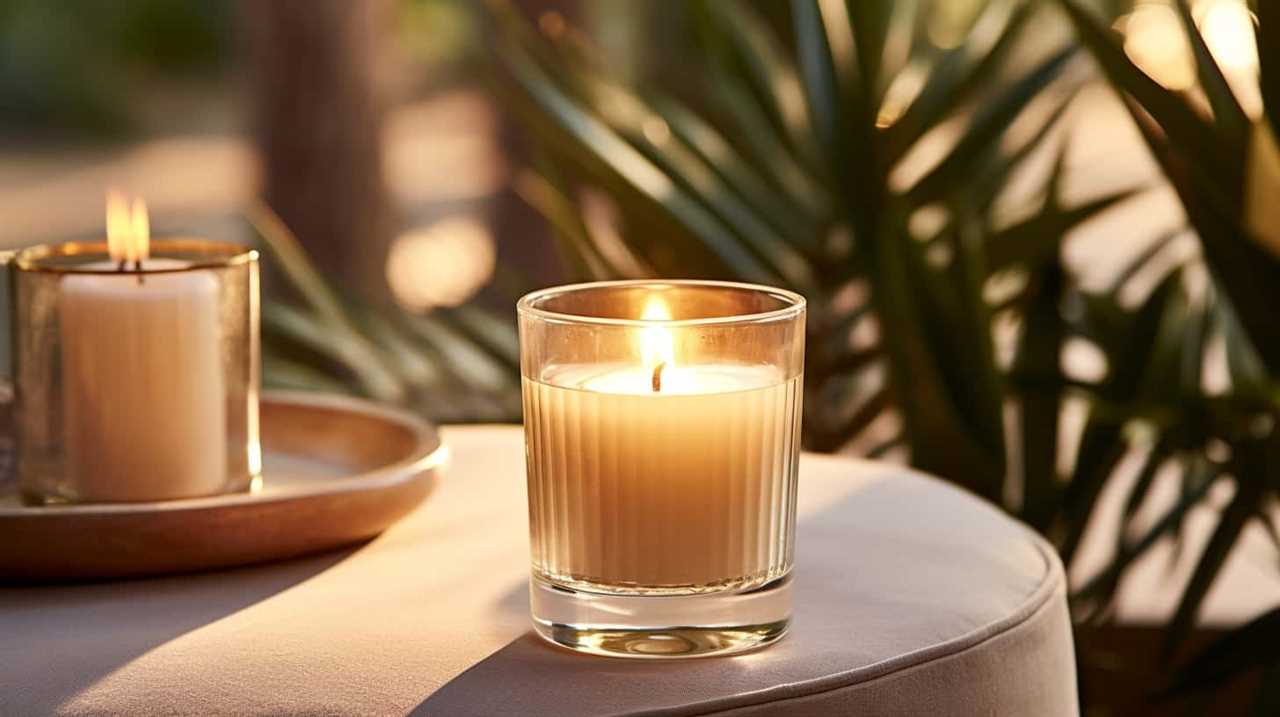
Wick Selection and Maintenance
When it comes to getting the most out of your candle’s scent, wick selection and maintenance play a crucial role.
Choosing the proper wick size ensures an optimal burn, allowing the fragrance to be released evenly.
Regularly trimming the wick not only prevents excessive sooting but also promotes a clean and efficient burn.
Additionally, mastering the art of wick centering techniques ensures that the flame stays centered, maximizing the scent throw and overall performance of your candle.
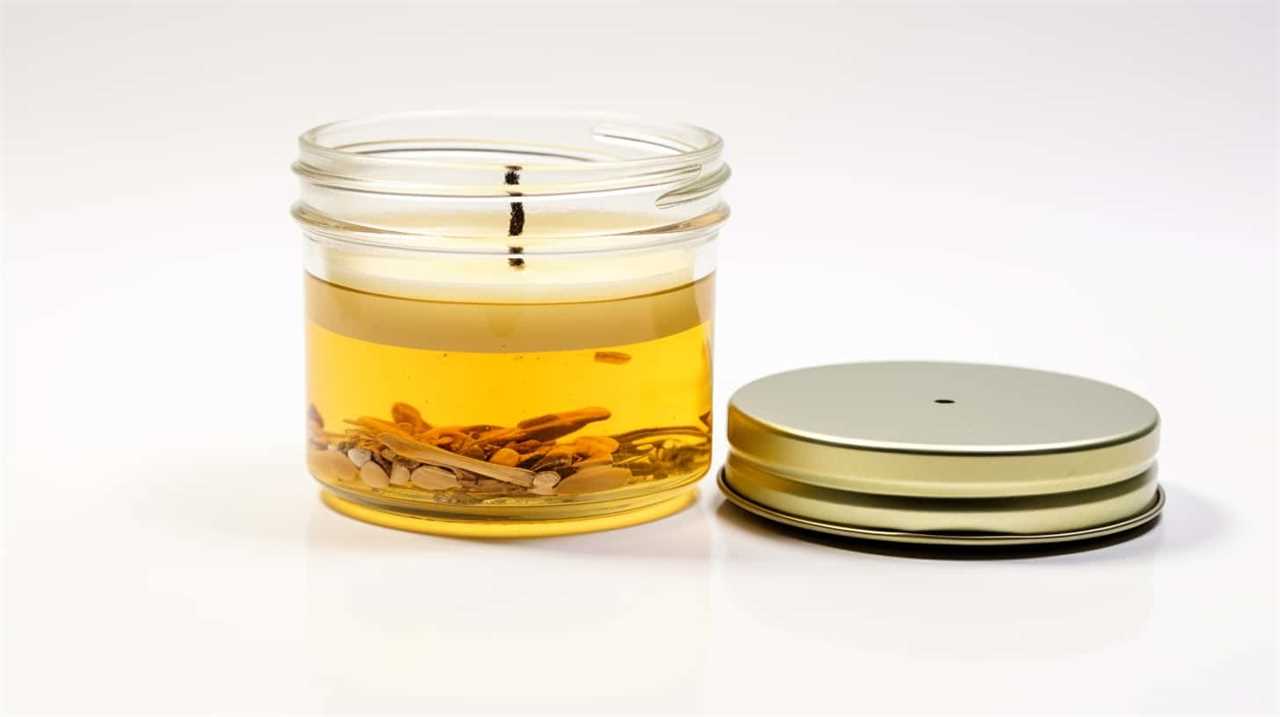
Proper Wick Size
To ensure that our candles emit a strong and pleasant scent, it’s crucial that we carefully select and maintain the proper wick size. The wick plays a vital role in the wick performance and fragrance compatibility of a candle.
Here are some key points to consider when it comes to choosing the right wick size:
- Consider the diameter of the candle: The size of the wick should be in proportion to the diameter of the candle. A larger diameter candle will require a thicker wick to ensure proper fragrance release.
- Think about the wax type: Different waxes have different melting points and burn characteristics. It’s important to choose a wick that’s compatible with the specific wax you’re using to achieve optimal performance.
- Pay attention to the fragrance load: Some fragrances may require a larger wick to adequately release their scent, while others may need a smaller wick to prevent overpowering.
- Regularly trim the wick: Maintaining the wick by trimming it to the appropriate length will help promote a clean and even burn, preventing excessive smoke and soot.
Trimming for Optimal Burn
To maintain an optimal burn and ensure the best scent release, we regularly trim the wick of our candles. Wick maintenance is an essential step in candle care that often gets overlooked.
A trimmed wick helps to control the size and shape of the flame, preventing it from becoming too large or flickering excessively. This not only ensures a cleaner and more even burn but also reduces the risk of soot and smoke.
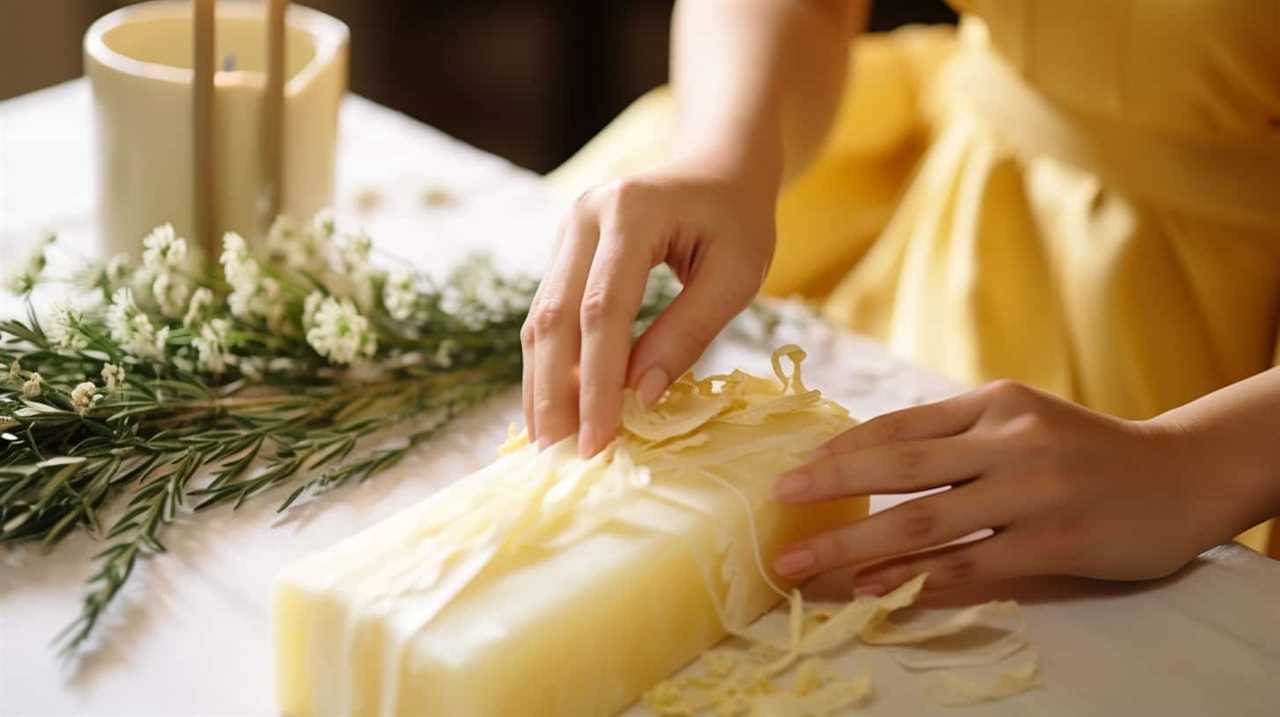
When trimming the wick, it’s important to use the right techniques. We recommend trimming the wick to about ¼ inch before each lighting. This can be easily done with a wick trimmer or scissors.
Wick Centering Techniques
We find that proper wick selection and maintenance are crucial for ensuring a well-centered and efficient burn in our candles. Wick positioning plays a vital role in achieving a clean and even burn, while wick alignment ensures that the flame remains at the center of the candle.
To help you achieve the best results, here are some essential tips for wick centering:
- Choose the right wick size: Select a wick that’s appropriate for the diameter of your candle. A wick that’s too small may result in a weak flame, while a wick that’s too large can cause excessive smoke and soot.
- Secure the wick in place: Use a wick holder or a wick centering tool to keep the wick upright and centered during the pouring process.
- Trim the wick before each use: Keeping the wick trimmed to approximately 1/4 inch ensures optimal burn performance and prevents excessive flickering or smoking.
- Monitor the wick during burning: If you notice the wick leaning or moving away from the center, gently reposition it using tweezers or a wick centering tool.
Candle Size and Burn Time
When it comes to candle size and burn time, there are a few key points to consider.
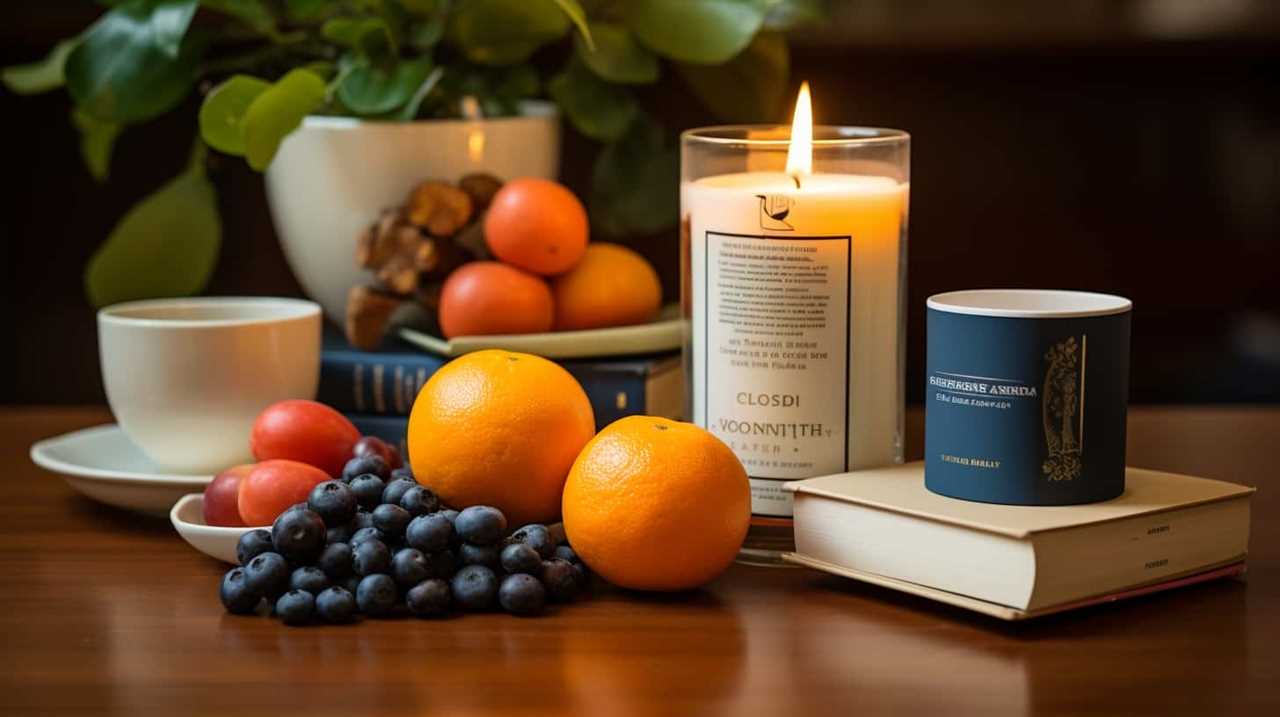
Firstly, a longer burn time means that you can enjoy the scent for a longer period of time.
Secondly, the size of the candle can have an impact on the strength of the scent throw. A larger candle has more wax and fragrance, resulting in a stronger scent.
Longer Burn Time, Stronger Scent
As we explore the factors that contribute to a longer burn time and a stronger scent in candles, it’s important to consider the size of the candle and its burn time. The size of a candle plays a significant role in both the fragrance intensity and the duration of the scent. Here are some key points to keep in mind:
- Larger candles generally have a longer burn time, allowing the scent to disperse over a longer period.
- Smaller candles may have a shorter burn time, resulting in a more concentrated scent.
- Candle fragrance concentration can vary based on the size of the candle, with larger candles often having a higher fragrance load.
- Burn time is influenced by factors such as the type of wax, wick size, and candle care.
Understanding how the size of a candle affects its burn time and scent longevity can help you choose the perfect candle for your needs. Now, let’s delve into how size affects scent throw.

Size Affects Scent Throw
Our candle’s scent throw can be influenced by the size of the candle and its burn time. The size of the candle matters because a larger candle has more surface area, allowing for a stronger scent throw. This means that a larger candle will release more fragrance into the air, filling the room with a delightful aroma. On the other hand, a smaller candle may have a more subtle scent throw.
Burn time also plays a role in the scent throw of a candle. The longer a candle burns, the more fragrance oils are released into the air. This results in a stronger scent throw that can fill a space more effectively. So, if you want a candle with a powerful aroma, opt for a larger size and allow it to burn for a longer period of time.
With the right combination of candle size and burn time, you can enjoy the full potential of your candle’s scent throw.
Scent Concentration and Quality
Although we may love a candle’s aesthetic, scent concentration and quality are essential for a truly enjoyable experience.
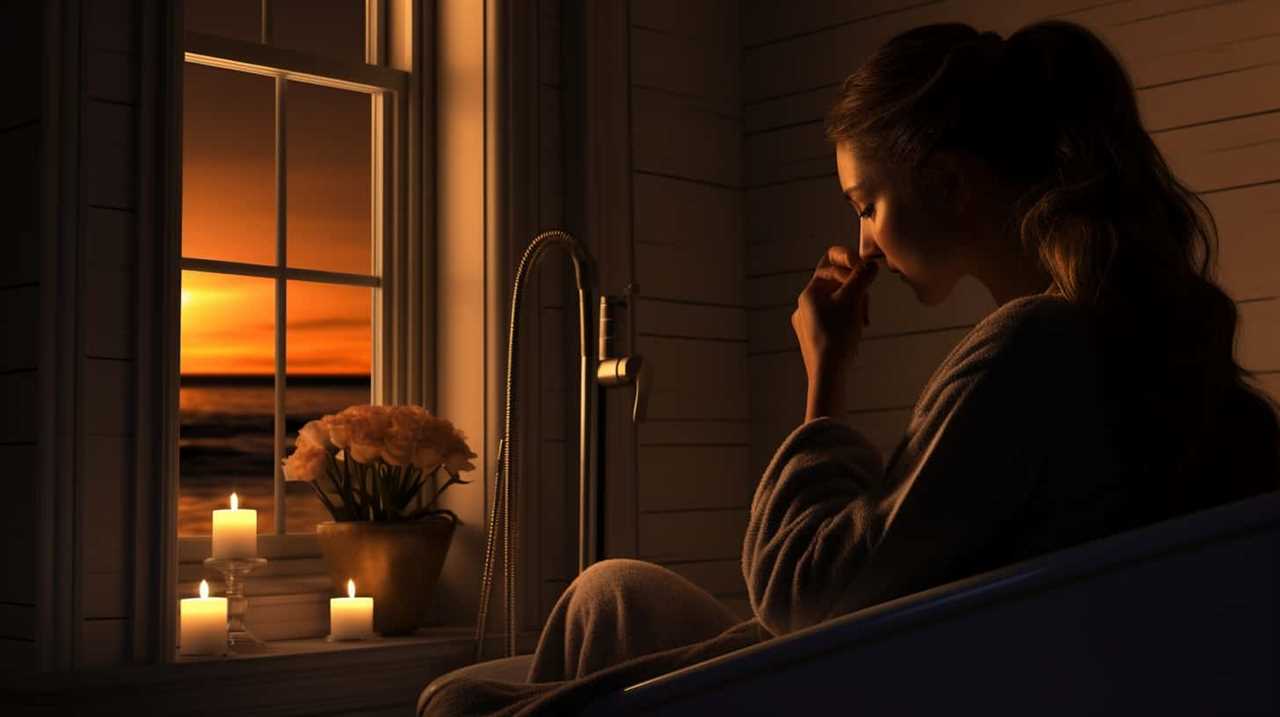
When it comes to scent concentration, it’s important to find a candle that has a strong fragrance throw. This means that the scent is released into the air and fills the room, creating a pleasant and inviting atmosphere.
Additionally, scent longevity is crucial for a candle to provide a lasting fragrance experience. A high-quality candle will continue to release its scent throughout its burn time, ensuring a consistent and enjoyable aroma.
To achieve this, fragrance oil selection is key. Choosing candles made with high-quality oils will result in a more potent and long-lasting scent that fills the room with delightful fragrance.
Candle Placement and Airflow
To maximize the scent of your candle, consider the placement and airflow in your space. The location where you place your candle plays a crucial role in how well its fragrance fills the room. Choose a central spot, away from drafts and obstructions, to ensure an even distribution of scent. Avoid placing the candle near open windows, air vents, or fans, as they can disrupt the airflow and diminish the fragrance.

Additionally, using scent-releasing techniques can enhance the aroma of your candle. You can try using candle warmers, wax melts, or reed diffusers as alternative ways to enjoy your favorite scents. By strategically placing your candles and utilizing these fragrance alternatives, you can create a more inviting and aromatic atmosphere in your space.
Now, let’s move on to discussing the storage and shelf life of candles.
Storage and Shelf Life of Candles
When storing your candles, it’s important to consider their shelf life and proper storage conditions. Proper storage not only helps to maintain the quality and fragrance of your candles but also prolongs their shelf life.
Here are some candle storage tips to ensure your candles stay fresh and ready to use:
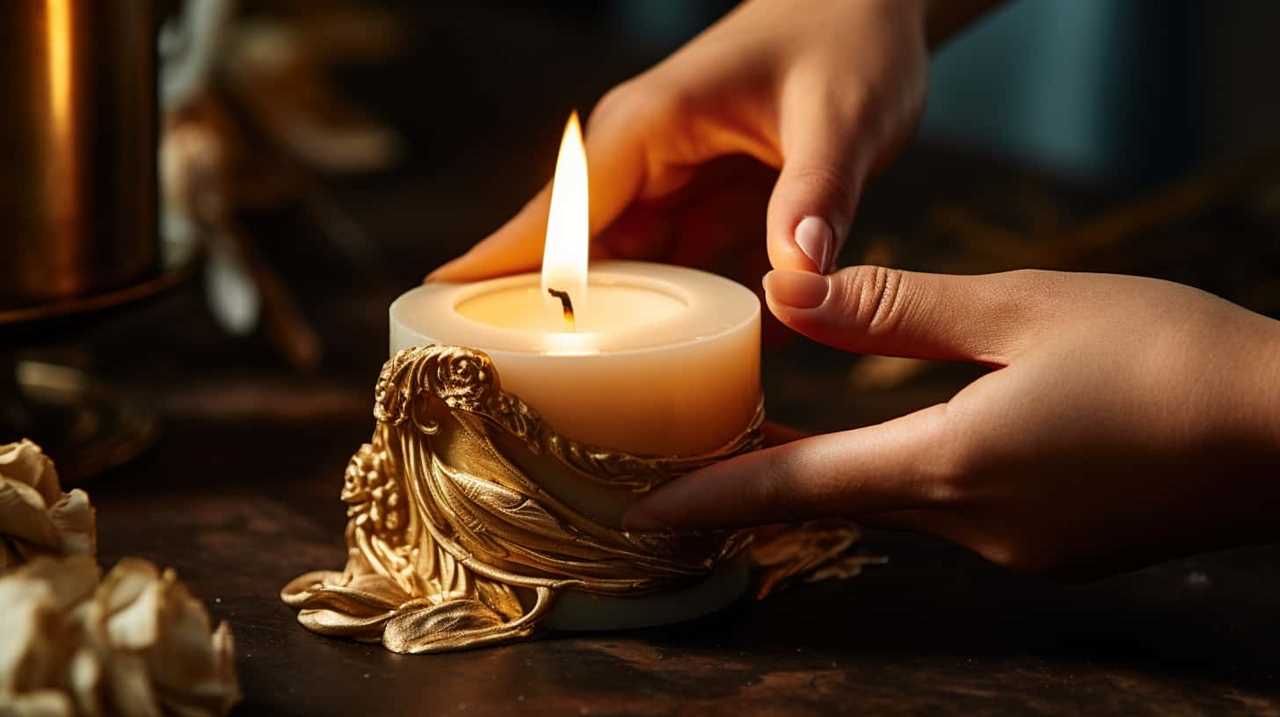
- Keep your candles in a cool, dry place away from direct sunlight.
- Store candles in an airtight container or wrap them in plastic to protect them from dust and humidity.
- Avoid storing candles near strong odors as they can absorb the scent.
- Place your candles upright to prevent warping and ensure even burning.
External Factors Affecting Scent Perception
Our sense of smell can be influenced by various external factors. When it comes to candles, the fragrance chemistry and personal scent tolerance play a significant role in how we perceive the scent. However, there are other factors that can affect our scent perception as well.
To better understand this, let’s take a look at the table below:
| External Factors | Impact on Scent Perception |
|---|---|
| Room temperature | High temperatures can intensify the fragrance, while low temperatures can weaken it. |
| Humidity | High humidity can dampen the scent, while low humidity can enhance it. |
| Air circulation | Good air circulation can help distribute the scent evenly, while poor circulation may result in a weaker scent. |
| Personal hygiene | Strong personal scents, such as perfumes or body lotions, can mask the candle fragrance. |
Frequently Asked Questions
Can I Use Any Type of Wax for Scented Candles?
We can use different types of wax for scented candles to enhance the fragrance and ensure a better burn. Choosing the right wax, like soy or beeswax, can provide benefits such as longer-lasting scent and a cleaner, healthier burn.
How Often Should I Trim the Wick of My Scented Candle?
When it comes to wick maintenance, we’ve got you covered! Regularly trimming the wick is a must for optimal candle burning. It helps prevent soot buildup, ensures a clean burn, and enhances the delightful scent experience.

How Long Can I Expect a Scented Candle to Burn?
When considering the burning time of a scented candle, several factors come into play. The size of the candle, the quality of the wax, and the environment in which it burns all affect how long it will last.
Does a Higher Scent Concentration Mean a Stronger Aroma?
A higher scent concentration does not necessarily mean a stronger aroma. While it can enhance effectiveness, other factors like the quality of fragrance oils, wick size, and burn time also contribute to scent intensity and longevity.
Can I Place My Scented Candle Near a Window or in a Drafty Area?
Placing candles outdoors or in drafty areas may affect their scent throw. It’s best to keep them in a still, enclosed space for maximum fragrance. Alternatively, try using candle warmers to release the aroma evenly.
Conclusion
In conclusion, to ensure your candle emanates an enticing aroma, consider the quality of the wax, the selection and maintenance of the wick, the size and burn time of the candle, the concentration and quality of the scent, the placement and airflow around the candle, and the storage and shelf life.
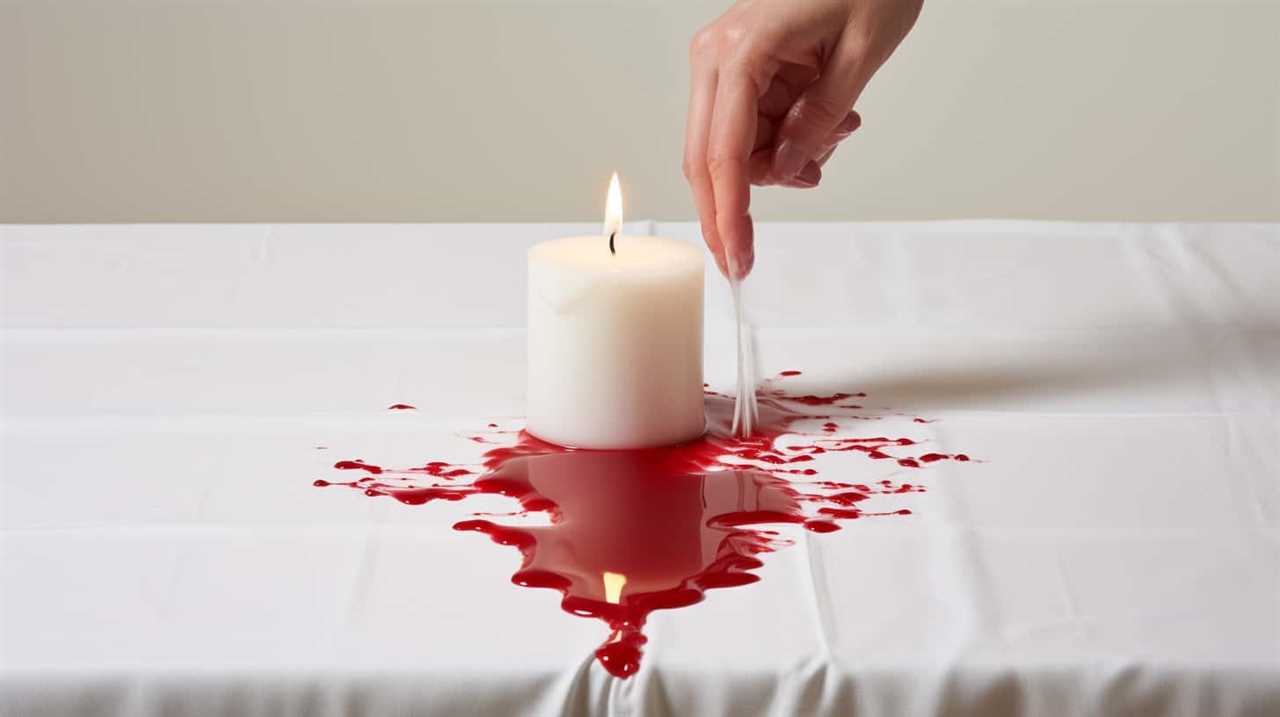
Remember, external factors such as drafts or strong odors can also affect the perceived scent.
So, with proper attention to these factors, you’ll have a scented candle that truly sings!






